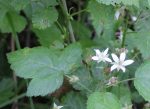 Also called dewberry, trailing blackberry is a deciduous mounding shrub or trailing vine and member of the rose family, Rosaceae, that also includes apple, almond, and lady’s mantle. It is native of western North America and occurs in California, Idaho, Montana, Oregon, and Washington as well as British Columbia and Baja California where it grows on prairies, woodlands, pastures, and disturbed sites such as clearings, burned areas and roadsides. Although often grown as an ornamental or for its flavorful fruit the plants tend to form colonies that are difficult to control.
Also called dewberry, trailing blackberry is a deciduous mounding shrub or trailing vine and member of the rose family, Rosaceae, that also includes apple, almond, and lady’s mantle. It is native of western North America and occurs in California, Idaho, Montana, Oregon, and Washington as well as British Columbia and Baja California where it grows on prairies, woodlands, pastures, and disturbed sites such as clearings, burned areas and roadsides. Although often grown as an ornamental or for its flavorful fruit the plants tend to form colonies that are difficult to control.
Description:Trailing blackberry grows two to five feet high and over six feet wide. Its thin branches have slender recurved prickles and root if they touch the soil. The leaves are alternate and consist of three oval leaflets with pointed tips and toothed margins. They are green above and pale white-green below with prickles on the petioles and major veins. The white male and female flowers appear on separate plants during the summer. They are fragrant, have five petals; those of female flower are wider than those of male flowers. The fruit is an elongated berry about one inch long. Fruit production is usually on canes more than a year old. Reproduction is by seed and rooting canes.
Control: Digging, hoeing, and tilling are effective if continued until no more sprouts appear but since resprouting is common, and seeds persist in the soil more than one treatment is usually required. Mowing can be used to prevent seed production. In severe cases herbicides such as glyphosate and triclopyr can be applied in late summer if only first year canes are present otherwise herbicides should be applied in early fall before dormancy occurs.